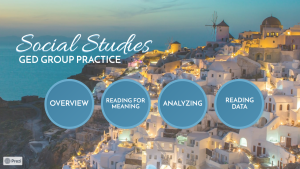49 GED Social Studies Practice
Learning Objectives
-
Use metacognitive reading strategies before, during and after reading fiction, non-fiction and graphics.
-
Appropriately paraphrase and summarize texts.
Study Guide
This chapter includes a study guide that can be navigated in a classroom setting or independently. You can access the study guide via the link below.
Work through the different sections of the chapter and discuss ideas and topics as they arise. If you’re working independently, take notes instead. Notes and active discussion will be helpful in navigating this week’s assignments.
Note on Study Guides
Study guides in this textbook are specific in-depth modules designed to be navigated via the attached presentation. The chapter below will offer general information on this week’s topics. For a deeper look at these topics, please access the presentation linked above.
Reading for Meaning
One of the main goals of the Social Studies GED is to read for meaning in texts relevant to this subject. Some specific objectives are:
- Identify the main idea of a social studies passage
- Use details to make inferences
- Determine vocabulary from context
- Identify how authors use language to express their points of view
- Determine if an author is using facts or opinions
- Determine whether or not a claim is supported by evidence

Analyzing
Another goal of the GED is analyzing historical events and arguments. Some of the main learning objectives include:
- Drawing conclusions by applying logic and reasoning to evidence presented
- Analyzing cause-and-effect relationships
- Describing connections between people, places, environments, processes, and events
- Putting events or processes in order
- Evaluating whether an author’s evidence is relevant or sufficient
- Finding bias or propaganda in a reading
Reading Data
The final GED study goal is Using data presented in visual form, including maps, charts, graphs, and tables. Some learning objectives are:
- Analyze information from maps, tables, charts, photographs, and political cartoons
- Represent textual data into visual form (charts, graphs, and tables)
- recognize the difference between correlation and causation between events
- Use data presented in charts, maps, and graphs to predict trends
Assignment: GED Ready
Complete a GED Ready test for Reading & Language Arts using your GED.com account. If you score 145 or higher, schedule your official GED test.
If cost is a concern, please look into your local Adult Basic Education program (most likely through your local community college). They will have programs to reduce or eliminate the cost of the exams and the GED Ready tests.
Assignment: Reading Zone Response (250 Words)
For Reading Zone, you must find a novel that is interesting to you and enjoyable to read. If you need help finding a Reading Zone book, please ask. Please read your Reading Zone book for a half-hour each day. On class days, there will be time in class dedicated to reading.
Create a response to this week’s reading that addresses the following prompts:
-
In one paragraph, summarize what you’ve read this week
-
In a second paragraph, answer this week’s prompt: What kind of perspectives does this author want you to experience? Who’s shoes do they want you to walk in? Explain.


